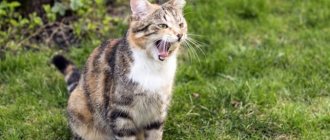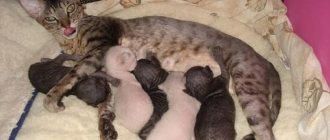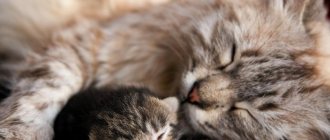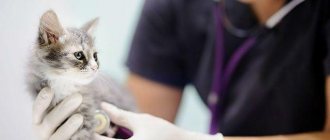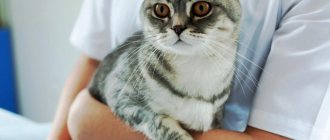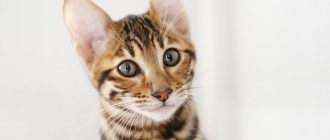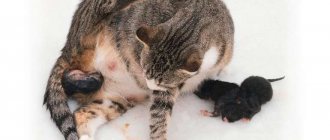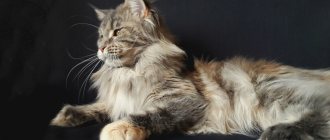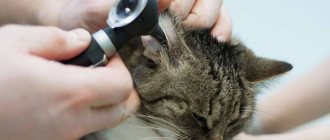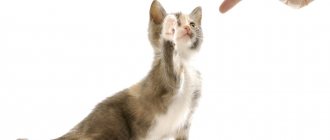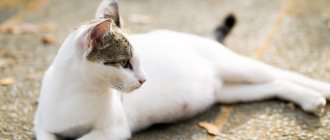“Soft paws - in the paws of a scratchy paw” is a well-known children's riddle about a cat, a beloved pet by many. Sometimes, for some reason, these very scratches (cat's claws) can injure the soft tissues of the paw. This happens when defective ingrown claws grow, which threaten the development of complications in the cat.
What causes a claw to grow into the paw pad?
Nature has thought of everything: to prevent claws from curling and growing into the skin, cats sharpen their claws on their own. Street cats do this in yards: the claws on their front paws are worn down on tree trunks, and the claws on their back paws are worn down while walking. Domestic cats have found another way out: they sharpen their claws on door frames or wallpaper. The owners do not like this situation, so many buy a scratching post - a special device for sharpening claws. A cat's claw should not reach the pad of its paw. There are several reasons why claws can grow to large sizes, bend and grow in:
- the cat moves little;
- sharpens claws poorly;
- hereditary and genetic predisposition.
An adult cat's body may lack vitamins and minerals. This leads to impaired growth of the claws and curvature of the claw plate. Statistically, older cats are more likely to have ingrown claws than young cats. Claws grow into the footpad due to injuries during play or a fall from a height: deformation or change in the length of the claw occurs.
What products are used to strengthen claws?
A popular vitamin complex is Brevers CALCIDEE 8 in 1. Its main advantage is that it contains only the most important vitamins for the pet’s body and
substances in the required balanced amount (vitamin D, calcium, phosphorus). Thanks to this, the vitamin complex can be taken with any food.
As an alternative, you can consider the Beaphar Kitty's Mix multivitamin complex, it contains a much higher amount of minerals and vitamins, and also contains at least 4% cod.
However, you should be careful when “prescribing” multivitamin complexes to your pet, because they contain many different vitamin groups, an excess of which in the pet’s body will not lead to anything good
Additionally, you can saturate your cat’s body with essential microelements and vitamins using oat sprouts. They can be purchased at any veterinary pharmacy or grown yourself. Sprouts must be added to the animal’s food at least once a week.
It is also recommended to introduce fresh, unheat-treated cod liver, fresh fish, meat and boiled vegetables into the cat’s diet. With an integrated approach, you can get rid of the problem in a matter of weeks.
In order to effectively deal with delamination of cat claws, it is necessary to understand why this happens.
However, there are cases when this phenomenon may indicate health problems.
How to tell if a cat has an ingrown claw
The owner will independently determine this problem based on the following symptoms :
- the cat refuses outdoor games, runs and jumps less;
- The pet is limping and carefully steps on its sore paw. When walking, an ingrown claw injures soft tissues, creates pain and discomfort;
- the cat pays more attention to the injured leg: licks the paw pad, tries to bite off the claw;
- at the site of ingrowth, the skin swells, turns red and becomes inflamed.
Hair loss in kittens
The kitten's body is especially sensitive. The appearance of alopecia can be caused by infection, too early birth, or a small amount of vitamins in the diet.
In addition to hypotrichosis, kittens often suffer from adenitis of the sebaceous glands. Sick pets have bald heads, ears and necks. Bald areas take the shape of a circle. Damaged skin peels and smells unpleasant. If left untreated, bald patches spread to the back and base of the ponytail. Inflamed glands cause severe itching, so your pet is constantly itching. The exfoliated scales become moist and acquire a yellow or gray tint.
How to cure at home
Not many people know about ways to help a pet in this situation. Do not straighten the claw or pull it out manually. This can cause harm. Take special nail clippers. Every owner should have them. Before the procedure, you need to disinfect them. Alcohol, vodka or chlorhexidine will do. Treat the area where the claw is ingrown with an antiseptic. Hold your paw firmly to prevent the cat from twitching. It's good if you have an assistant. He will fix the animal, you will carry out the procedure. Use pliers to cut off the ingrown claw down to the pink part. Blood vessels pass through there and should not be damaged. After trimming, the ingrown claw is pulled out with a sharp movement using tweezers or nippers. The procedure is painful, the animal will struggle. Therefore, it is important to do everything quickly. The cut claw is easily removed. Does not injure neighboring tissues.
Treat the wound with an antiseptic to disinfect and prevent infection. You can use furatsilin or hydrogen peroxide. Lubricate the removal site with antibacterial ointment. Cut off the rest of the claw as much as possible so that it does not touch the paw pad.
The procedure can be carried out at home in the absence of infection and inflammation of the wound. If there is redness and swelling on the soft tissues, contact your veterinarian.
Treatment methods
Treatment of an ingrown toenail is carried out using different methods. The main and most reliable method is surgery. Thumb surgery is performed on an outpatient basis and does not require hospitalization. There are several modifications of operations, incl. using radio waves and lasers. The doctor decides which operation to perform on a given patient, depending on the specific situation.
Anesthesia for operations on ingrown toenails is always conductive - a small amount of anesthetic is injected into the base of the finger on both sides under the skin, after which you need to wait 5 - 10 minutes, and the finger will be completely anesthetized. With this type of anesthesia, the operation is completely painless in 100% of cases.
Let's consider the main types of operations. They all solve the problem of how to remove an ingrown toenail.
Regional resection of the nail plate using radio waves or lasers.
This method is the most common, low-traumatic and reliable; it involves removing the ingrown edge of the nail (1–2 mm), treating a fragment of the growth zone with a radio wave or laser, and removing purulent tissue along the edge of the periungual fold. It should be noted that there is no fundamental difference between radio wave and laser exposure; both of these devices ensure reliable destruction of the desired fragment of the growth zone with minimal damage to neighboring tissues.
Help from a veterinarian
The veterinary clinic will help in the most severe cases: when the wound becomes infected and the claw grows deep into the paw. The doctor will conduct an examination. Assess the complexity of the case, the degree of claw ingrowth and the need for surgical intervention.
If the claw is not deeply ingrown and there is no inflammation, the veterinarian will remove the claw using special tools. The wound will be treated with an antiseptic to avoid inflammation. If the wound festers, a decision is made to operate. It is performed under local anesthesia. The place of suppuration is opened, the pus and the ingrown claw are removed. The wound is disinfected.
In severe cases, the operation is performed under general anesthesia. A small incision is made at the site where the claw grows in. The claw is cut off and carefully removed. The accumulated pus is cleaned out. The wound is treated with an antiseptic solution. At the end, a sterile bandage is applied.
Causes of ingrown toenails
- Improper
nail care is the main cause of ingrown nails, when the corners of the nail are cut too deep, which leads to improper growth of the nail plate and ingrowth into the soft tissue of the periungual fold. Also, the corner of the nail may not be trimmed enough and the free edge will dig into the side ridge; in the presence of hyperhidrosis, this can provoke an ingrowth. - One of the factors contributing to the development of an ingrown nail into the lateral edge of the nail fold is the congenital or acquired expansion of the strip of the growth layer of the nail plate. A wide growth zone leads to the formation of a wide nail plate, as a result, part of the growing edge puts pressure on the nail fold, injuring it. Inflammation develops and, as a result, excessive growth of soft tissue occurs in the area of the nail fold.
- Wearing uncomfortable tight shoes with a narrow toe provokes excessive pressure from the growing edge into the side bolster. Shoes of the wrong size can also be considered a risk factor: the choice of shoe size is the size of the foot plus 0.5-1 cm.
- Bacterial and fungal infections can cause changes in the structure of the nail plate, making it thicker and causing unnecessary pressure on the nail bed and lateral folds.
- Congenital bone deformities of the feet, including Rubinstein-Taybi syndrome (wide first toe syndrome) and Ostler syndrome.
- Prolonged compression of the toes with a plaster cast or wearing compression garments can also cause the formation of an ingrown edge of the nail plate.
- Acquired bone deformities - flat feet, wide feet, sharp deviation of the big toe inward or outward.
- Anatomical features of the structure of the foot and toes (physiologically large, fleshy periungual ridges).
- Foot injuries.
- Excess body weight.
- Diseases - diabetes, gout, psoriasis, rheumatoid arthritis, collagenosis, etc.
Postoperative care
Immediately after removing an ingrown nail, your veterinarian may prescribe antibiotics. They should be taken immediately to avoid the inflammatory process. Additionally, it is recommended to give your pet a complex of minerals and vitamins. In order for injured tissue to quickly recover and heal, immunomodulators are prescribed.
To avoid getting an infection in your foot, wash your floors more often. The room where the pet lives must be clean. Walking and active games are temporarily contraindicated for cats. It is necessary to keep the paw at rest until it has fully recovered.
Classification of onychocryptosis
Onychocryptosis can go through three stages of development:
- mild, when changes in the plate are not yet visible, but there is pain, discomfort, swelling and inflammation of the periungual ridges;
- moderate, when the tissues of the terminal phalanx are hyperemic, edematous, and infiltrated. The nail plate becomes dull and thickened;
- heavy when the plate becomes thin and brittle. The periungual ridges are swollen and covered with hypergranulations. When the nail folds are affected on both sides, the volume of the phalanx increases.
Onychocryptosis can occur both without inflammation and with the addition of infection.
Prevention methods
To prevent the claw from growing into the paw pad, veterinarians recommend following simple recommendations:
- create conditions for natural grinding of claws. Allow the pet to sharpen its claws to the required height;
- For cats with a genetic predisposition to ingrown and deformed claws, have multiple nail trimming procedures performed at your veterinary clinic. This will straighten the shape of the claw plate and prevent it from growing into the paw;
- If you do not practice walking your cat outside, purchase a high-quality nail clipper. Trim the nails regularly and then carefully file down the edges;
- Inspect your pet's paws as often as possible to identify ingrown claws and other defects. If a problem is detected at an early stage, the claw can be removed without surgery, healing will be faster and easier;
- Protect the animal from injuries to limbs and falls from great heights. This is necessary to prevent deformation and change in the size of the claw.
Remember! If the situation of a claw growing into a paw has already happened, it may happen again. Therefore, carefully monitor your pet.
It is important for owners to know that the most problematic claw is the claw on the fifth toe of the front paws. Anatomically, it is located on the back side above the rest of the cat's fingers. He is actively growing, nothing bothers him. Due to its location, this claw does not reach the surface on which cats grind their claws. Therefore, it is most often the one that grows into soft tissues. The problem of ingrown claws is a common pathology in cats and dogs. It is important to regularly inspect your pet's paws and follow the prevention recommendations above. If you notice an ingrown claw, contact a veterinary clinic as soon as possible. This will help avoid complications. The extraction procedure will be less painful and complicated. No surgery or long recovery period is required.
Trim your nails regularly to protect yourself and your pet from unnecessary problems.
Why is there a problem?
Nail-related disorders are often reported in pets. In some cats, the claw may simply be turned in the opposite direction; in others, it comes off completely. The problem is a consequence of the active lifestyle of the feline family, which often climb trees or sharpen their nails on furniture. Normally, the pad and nail plate of cats should not touch. When the claws grow quickly and become rough, the following factors can affect this:
- insufficiently active lifestyle;
- improper grinding of nails;
- mechanical damage, in which the owner notices that the cat has injured either a claw or it has completely come off;
- predisposition to pathology at the genetic level.
Complications
Complications of onychocryptosis occur with prolonged course and further development of the inflammatory process. Such complications include:
- abscess of the toe - swelling, redness of the entire nail phalanx and the formation of a cavity with purulent contents;
- gangrene of the toe - irreversible necrosis of the soft tissues of the foot, accompanied by blackening of the skin;
- osteomyelitis of the nail phalanx of the finger - an infectious inflammatory process that affects the entire bone of the phalanx;
- lymphangitis and/or lymphadenitis is inflammation of the lymphatic vessels and lymph nodes, developing as a result of the spread of the inflammatory process from the source of infection.
